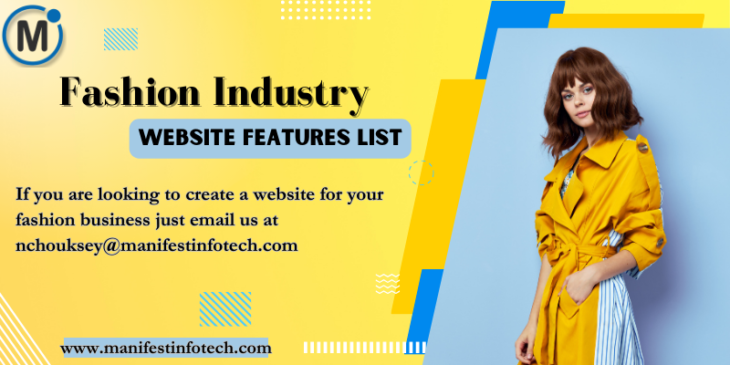
A fashion business website typically requires a mix of engaging, visually appealing, and user-friendly features. Here’s a list of potential features:
𝐔𝐬𝐞𝐫-𝐅𝐫𝐢𝐞𝐧𝐝𝐥𝐲 𝐈𝐧𝐭𝐞𝐫𝐟𝐚𝐜𝐞:
𝟏. 𝐇𝐨𝐦𝐞𝐩𝐚𝐠𝐞: Visually captivating, easy navigation, and prominently displaying key categories or collections.
𝟐. 𝐒𝐞𝐚𝐫𝐜𝐡 𝐅𝐮𝐧𝐜𝐭𝐢𝐨𝐧𝐚𝐥𝐢𝐭𝐲: Allows users to find specific clothing items, brands, or styles.
𝟑. 𝐌𝐨𝐛𝐢𝐥𝐞 𝐑𝐞𝐬𝐩𝐨𝐧𝐬𝐢𝐯𝐞𝐧𝐞𝐬𝐬: Ensures the site looks and functions well on various devices.
𝐏𝐫𝐨𝐝𝐮𝐜𝐭 𝐏𝐫𝐞𝐬𝐞𝐧𝐭𝐚𝐭𝐢𝐨𝐧 𝐚𝐧𝐝 𝐈𝐧𝐟𝐨𝐫𝐦𝐚𝐭𝐢𝐨𝐧:
𝟒. 𝐏𝐫𝐨𝐝𝐮𝐜𝐭 𝐂𝐚𝐭𝐚𝐥𝐨𝐠: Organized by categories (e.g., clothing types, brands, or trends).
𝟓. 𝐇𝐢𝐠𝐡-𝐐𝐮𝐚𝐥𝐢𝐭𝐲 𝐈𝐦𝐚𝐠𝐞𝐬: Clear visuals displaying products from various angles.
𝟔. 𝐏𝐫𝐨𝐝𝐮𝐜𝐭 𝐃𝐞𝐭𝐚𝐢𝐥𝐬: Descriptions, sizes, materials, care instructions, and customer reviews.
𝟕. 𝐕𝐢𝐫𝐭𝐮𝐚𝐥 𝐓𝐫𝐲-𝐎𝐧: Technology allowing users to visualize how clothes might look on them.
𝟖. 𝐒𝐢𝐳𝐞 𝐆𝐮𝐢𝐝𝐞𝐬: Assisting customers in finding the right fit.
𝐔𝐬𝐞𝐫 𝐈𝐧𝐭𝐞𝐫𝐚𝐜𝐭𝐢𝐨𝐧 𝐚𝐧𝐝 𝐄𝐧𝐠𝐚𝐠𝐞𝐦𝐞𝐧𝐭:
𝟗. 𝐔𝐬𝐞𝐫 𝐀𝐜𝐜𝐨𝐮𝐧𝐭𝐬/𝐏𝐫𝐨𝐟𝐢𝐥𝐞𝐬: For saving favorites, order history, and personalized recommendations.
𝟏𝟎. 𝐖𝐢𝐬𝐡𝐥𝐢𝐬𝐭: Allowing users to save items they like for future reference or purchase.
𝟏𝟏. 𝐂𝐮𝐬𝐭𝐨𝐦𝐞𝐫 𝐑𝐞𝐯𝐢𝐞𝐰𝐬 𝐚𝐧𝐝 𝐑𝐚𝐭𝐢𝐧𝐠𝐬: Feedback on products and overall shopping experience.
𝟏𝟐. 𝐒𝐭𝐲𝐥𝐞 𝐆𝐮𝐢𝐝𝐞𝐬 𝐨𝐫 𝐋𝐨𝐨𝐤𝐛𝐨𝐨𝐤𝐬: Inspiring users with fashion trends, outfit ideas, or styling tips.
𝟏𝟑. 𝐒𝐨𝐜𝐢𝐚𝐥 𝐌𝐞𝐝𝐢𝐚 𝐈𝐧𝐭𝐞𝐠𝐫𝐚𝐭𝐢𝐨𝐧: Sharing fashion trends, new arrivals, or customer photos.
𝐄-𝐜𝐨𝐦𝐦𝐞𝐫𝐜𝐞 𝐅𝐞𝐚𝐭𝐮𝐫𝐞𝐬:
𝟏𝟒. 𝐒𝐡𝐨𝐩𝐩𝐢𝐧𝐠 𝐂𝐚𝐫𝐭: Seamless and easy-to-use for adding and managing items.
𝟏𝟓. 𝐒𝐞𝐜𝐮𝐫𝐞 𝐏𝐚𝐲𝐦𝐞𝐧𝐭 𝐆𝐚𝐭𝐞𝐰𝐚𝐲: Multiple payment options with robust security measures.
𝟏𝟔. 𝐂𝐡𝐞𝐜𝐤𝐨𝐮𝐭 𝐏𝐫𝐨𝐜𝐞𝐬𝐬: Streamlined, with guest checkout options to reduce friction.
𝟏𝟕. 𝐏𝐫𝐨𝐦𝐨𝐭𝐢𝐨𝐧𝐬 𝐚𝐧𝐝 𝐃𝐢𝐬𝐜𝐨𝐮𝐧𝐭𝐬: Offering deals, coupons, or seasonal discounts.
𝐋𝐨𝐜𝐚𝐥𝐢𝐳𝐚𝐭𝐢𝐨𝐧 𝐚𝐧𝐝 𝐏𝐞𝐫𝐬𝐨𝐧𝐚𝐥𝐢𝐳𝐚𝐭𝐢𝐨𝐧:
𝟏𝟖. 𝐋𝐨𝐜𝐚𝐥𝐢𝐳𝐚𝐭𝐢𝐨𝐧: Providing currency options, size conversions, and shipping information based on the user’s location.
𝟏𝟗. 𝐏𝐞𝐫𝐬𝐨𝐧𝐚𝐥𝐢𝐳𝐞𝐝 𝐑𝐞𝐜𝐨𝐦𝐦𝐞𝐧𝐝𝐚𝐭𝐢𝐨𝐧𝐬: Using AI or algorithms to suggest products based on user preferences.
𝟐𝟎. 𝐋𝐚𝐧𝐠𝐮𝐚𝐠𝐞 𝐎𝐩𝐭𝐢𝐨𝐧𝐬: Multilingual support for a broader audience reach.
𝐌𝐚𝐫𝐤𝐞𝐭𝐢𝐧𝐠 𝐚𝐧𝐝 𝐁𝐫𝐚𝐧𝐝𝐢𝐧𝐠:
𝟐𝟏. 𝐍𝐞𝐰𝐬𝐥𝐞𝐭𝐭𝐞𝐫 𝐒𝐢𝐠𝐧𝐮𝐩: Subscriptions for updates on new arrivals, trends, or promotions.
𝟐𝟐. 𝐁𝐥𝐨𝐠/𝐄𝐝𝐢𝐭𝐨𝐫𝐢𝐚𝐥𝐬: Creating content on fashion tips, industry news, and brand stories.
𝟐𝟑. 𝐏𝐫𝐨𝐦𝐨𝐭𝐢𝐨𝐧𝐚𝐥 𝐁𝐚𝐧𝐧𝐞𝐫𝐬/𝐏𝐨𝐩-𝐮𝐩𝐬: Highlighting sales, new collections, or limited-time offers.
𝐁𝐮𝐬𝐢𝐧𝐞𝐬𝐬 𝐌𝐚𝐧𝐚𝐠𝐞𝐦𝐞𝐧𝐭 𝐓𝐨𝐨𝐥𝐬 (𝐟𝐨𝐫 𝐟𝐚𝐬𝐡𝐢𝐨𝐧 𝐛𝐫𝐚𝐧𝐝𝐬/𝐫𝐞𝐭𝐚𝐢𝐥𝐞𝐫𝐬):
𝟐𝟒. 𝐈𝐧𝐯𝐞𝐧𝐭𝐨𝐫𝐲 𝐌𝐚𝐧𝐚𝐠𝐞𝐦𝐞𝐧𝐭: Tracking and managing stock levels and variants.
𝟐𝟓. 𝐀𝐧𝐚𝐥𝐲𝐭𝐢𝐜𝐬 𝐚𝐧𝐝 𝐑𝐞𝐩𝐨𝐫𝐭𝐢𝐧𝐠: Insights on user behavior, popular products, and sales trends.
𝐎𝐭𝐡𝐞𝐫 𝐂𝐨𝐧𝐬𝐢𝐝𝐞𝐫𝐚𝐭𝐢𝐨𝐧𝐬:
𝟐𝟔. 𝐀𝐛𝐨𝐮𝐭 𝐔𝐬/𝐂𝐨𝐧𝐭𝐚𝐜𝐭 𝐏𝐚𝐠𝐞: Information about the brand, mission, and contact details.
𝟐𝟕. 𝐅𝐀𝐐 𝐒𝐞𝐜𝐭𝐢𝐨𝐧: Answers to common queries regarding orders, returns, etc.
These features can vary based on the specific niche within the fashion industry—whether it’s apparel, accessories, luxury brands, or sustainable fashion.
If you are looking to create a website for your fashion industry just email us at nchouksey@manifestinfotech.com or Skype id: live:76bad32bff24d30d
𝐅𝐨𝐥𝐥𝐨𝐰 𝐔𝐬:
𝐋𝐢𝐧𝐤𝐞𝐝𝐢𝐧: linkedin.com/company/manifestinfotech
𝐅𝐚𝐜𝐞𝐛𝐨𝐨𝐤: facebook.com/manifestinfotech/
𝐈𝐧𝐬𝐭𝐚𝐠𝐫𝐚𝐦: instagram.com/manifestinfotech/
𝐓𝐰𝐢𝐭𝐭𝐞𝐫: twitter.com/Manifest_info
#FashionWebsiteFeatures #FashionTech #WebDesignForFashion #StyleBizFeatures #DigitalFashionExperience #WebsiteDevelopment #FashionTechTrends #OnlineFashionStore #FashionWebsiteDesign #ClothingWebsiteFeatures #FashionBlogFeatures #EcommerceForFashion #FashionUserExperience #TechInFashionIndustry #FashionSiteFunctions #DigitalStyleDesign #FashionTechInnovation #WebFeaturesForFashion #FashionEcommerce #FashionMarketingTools #ManifestInfotech #Blogs #Indore #India